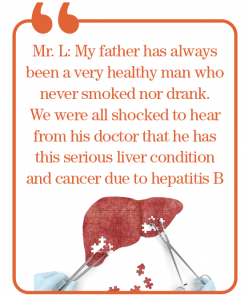
The Dangers of Hepatitis B Infection
Mr. L, a patient in his late forties, came to my clinic one day looking quite anxious and requested for a liver check-up. As part of what I do for all my patients, I tried to find out his concerns and allay his fears. It turned out that his father was recently admitted to a hospital for vomiting blood, and was diagnosed with liver cirrhosis (liver hardening) as well as liver cancer.
“My father has always been a very healthy man who never smoked nor drank. We were all shocked to hear from his doctor that he has this serious liver condition and cancer due to hepatitis B,” Mr. L lamented to me.
As I listened to Mr. L, I could not help but think that his father could have avoided this situation if he had been diagnosed with hepatitis B earlier, and received appropriate treatment to prevent liver cirrhosis and reduce his risk of liver cancer.
I did not tell this to Mr. L at that point in time as it would not have helped him, and it might have actually brought him more distress instead. I reassured him that he made the right decision to have an early liver checkup and also shared with him information about various forms of liver diseases, particularly hepatitis B virus infection and the process of liver cirrhosis arising from ongoing uncontrolled liver injury.

THE SILENT KILLER
Like many liver conditions, hepatitis B infection is known as a silent killer as it does not produce any symptoms until the liver is substantially damaged. It is caused by the hepatitis B virus and most people have a chronic type of hepatitis B infection, meaning that it lasts more than 6 months and is often lifelong. Chronic hepatitis B infection increases risk of developing liver cirrhosis, liver failure and liver cancer.
Worldwide, there are more than 300 million people suffering from chronic hepatitis B infection. It is estimated that 3.6% of the population or 180,000 Singapore residents are infected with the hepatitis B virus. Although hepatitis B infection can be easily identified with a simple blood test, only a small proportion of hepatitis B patients are diagnosed due to the fact that most patients do not have any symptoms in the early phases. Additionally, there is no effective nationwide hepatitis B screening strategy currently in place in Singapore.
Many known hepatitis B patients are diagnosed by chance during health screenings, while a smaller proportion of patients are only diagnosed when the liver has been severely damaged and produces symptoms such as jaundice (yellow skin or eyes), upper abdominal pain, water retention or internal bleeding.
The hepatitis B virus is transmitted by the blood or body fluids of an infected person. Hence, we can catch this infection if we come into contact with the blood of an infected person or have intimate sexual activity with him/her. Sometimes, a cluster of hepatitis B infections is found within a family, mainly due to the fact that an infected mother can pass the virus to her child during childbirth or cross infection can occur between spouses. However, it is important to note that we would not be infected with this virus if we breathe the same air, shake hands, hug, and share food or drinks with an infected person.
 TREATMENT OF HEPATITIS B
TREATMENT OF HEPATITIS B
Not all cases of hepatitis B infection require medication. The majority of hepatitis B patients have an inactive form of infection and only require regular checkups, blood tests and an ultrasound scan to ensure the liver remains in good shape and the virus is not flaring up. For others who have the active form of hepatitis B that causes liver injury, there are oral medications that can very effectively suppress the virus and help the liver to recover. These medications are well tolerated, and side effects are rare.
For people without hepatitis B infection, they can protect themselves by receiving 3 doses of hepatitis B vaccine. Immunity is often lifelong. Universal vaccination for all newborns has been implemented in Singapore since 1987 and this has significantly reduced the number of hepatitis B cases among our younger population.
THE CASE OF MR. L
Coming back to Mr. L’s case, upon examination, I found that he was physically well apart from being overweight. Mr. L was relieved to find out that he was negative for hepatitis B infection and went on to receive 3 doses of hepatitis B vaccination to protect himself from the disease.

Nonetheless, I diagnosed him with fatty liver disease from his ultrasound liver scan and high cholesterol from his blood test, both of which were related to his excessive body weight and lack of exercise. The silver lining was that his fatty liver disease had not resulted in any liver scarring and he could take action to have it treated.
“Fatty liver is rather common in Singapore and Asia, affecting up to 10-30% of adults,” I explained to Mr. L, who was rather surprised to know that fatty liver is so common. “It is a disease of our modern lifestyle and diet, with similar risk factors that lead to obesity, diabetes mellitus, high blood pressure and high cholesterol.”
I further explained to Mr. L that an important component of treatment of fatty liver is having a healthy lifestyle via:
• Avoidance of excessive alcohol intake,
• Eating a well-balanced and healthy diet, and
• Engaging in regular exercise.
This improves the condition in some people. Medications can also be used to treat fatty liver disease, especially if lifestyle changes are unsuccessful or not possible. After discussing the treatment options, Mr. L was very determined to treat his fatty liver with just lifestyle changes. By exercising 5 times a week and cutting down on sugar intake, he reduced his weight by almost 7kg over a 9 month period.
Nine months after his first visit, Mr. L came back to me for a follow-up visit to check his liver. He was very pleased with his latest liver check which showed his liver in tip-top condition and his fatty liver well under control. As for his father, Mr. L mentioned that the liver failure stabilized after receiving anti-hepatitis B medication and the liver cancer was under control with treatment. His father is now on the waiting list to receive a liver transplantation as a cure for his liver hardening and liver cancer.
PREVENTION OVER CURE
It might sound cliché, but as the old adage goes: “Prevention is better than cure”. This saying, coined by the Dutch philosopher Desiderius Eramus in the 1500s, rightly points out that we should always take a proactive approach in keeping our health in tip-top condition and undergo a necessary health check once a year. It might take us half a day or even a full day at the clinic to undergo the consultation, blood test and scan, but this is the best way to detect any underlying conditions in their early stages that are still amendable to simple treatment to prevent full blown disease. A health check could very well prove to be the best investment in our life!

Dr Tan Poh Seng
Gastroenterologist
PS Tan Digestive & Liver Centre
MBBS (Hons), M.Med (Int Med),
MRCP (UK), FAMS (Gastroenterology), FRCP (Edin)
Dr Tan Poh Seng is a senior consultant gastroenterologist in Singapore with many years of clinical expertise in digestive diseases as well as endoscopy such as gastroscopy, colonoscopy and polypectomy. Before starting his own private practice, Dr Tan was the Director of Clinical Services of the Division of Gastroenterology & Hepatology, National University Hospital (NUH) and a senior consultant of the Liver Transplant Programme at the National University Centre for Organ Transplantation. He was also an assistant professor at the Yong Loo Lin School of Medicine, National University of Singapore. Dr Tan strongly believes in providing personalised and patient-centred treatment and endoscopy to meet the medical needs of his patients.











